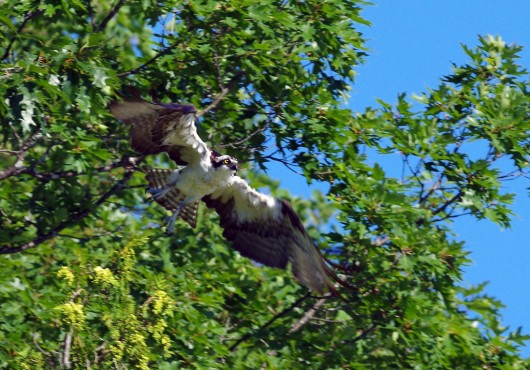 I would have thought the fish this osprey spotted in Ghost Bay didn’t have a chance. But this time the fish escaped. Look at that yellow eye and you can know it was among the last things many a fish saw. Osprey grab fish with their talons and not their beaks and they fly off to feed holding the fish in a head forward position. Less drag means they can manage a bigger fish in flight.
I would have thought the fish this osprey spotted in Ghost Bay didn’t have a chance. But this time the fish escaped. Look at that yellow eye and you can know it was among the last things many a fish saw. Osprey grab fish with their talons and not their beaks and they fly off to feed holding the fish in a head forward position. Less drag means they can manage a bigger fish in flight.
Osprey populations were decimated in the 1950’s and 1960’s mostly because of DDT use. Raptors are top-of-the-food-chain creatures. This means everybody else’s DDT collected in their bodies. They had no way to expel the toxins. One result? The bird’s calcium metabolism was interfered with. DDT-infested osprey laid eggs with shells so thin that they broke during incubation. But with DDT-bans in place for many decades now, the population has recovered. Wikipedia reports that the only raptor with a wider distribution is the peregrine falcon.
Osprey leave Long Lake (and Michigan) in the fall and return in the spring. Scientists are learning more about their wintering activities by attaching solar-battery backpacks to birds. During their 15-20 year lifespan, they may log 160,000 migration flight miles. During 13 days in 2008, one osprey flew 2700 miles–all the way from Martha’s Vineyard in Massachusetts to French Guiana in South America. Young male osprey will spend two seasons in warmer places than Michigan and then return annually to the area where they hatched. Females disperse more widely.
If you know where the osprey are nesting on Long Lake, please leave a comment and let me know. It’s been many years since the stick nest atop the utility pole at the southern end of the lower bowl disappeared. And watch for these “fish hawks” on our lake. Usually it takes an osprey 12 minutes to catch a fish. That’s not a study at our lake, but let’s just say that my fishing success statistics are not quite that good.

